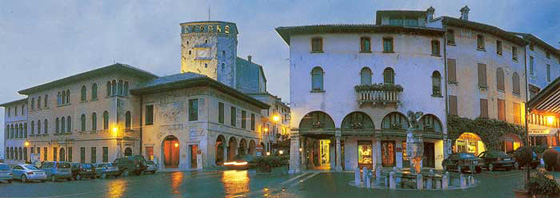
Nestled in an enchanting hilly landscape, Asolo is one of the best-known and loveliest towns in Italy.
Works of great historical, artistic and cultural value, alleyways, mansions and arcades. speak of an ages-old past and stand almost as if among the halls of a permanent exhibition, where you can admire nature's unique work combined with the genius of the human mind. The concept of a "widespread museum" finds one of its best expressions in this place.
 The clearly medieval imprint of Asolo huddles within the ancient walls and is dominated by the Fortress, an imposing medieval construction built on Mount Ricco to guard the city. Central Piazza Garibaldi with its sixteenth-century fountain topped by the winged lion of St. Mark might be considered the heart of the city; from here you are within a short walk of some of Asolo's main monuments: The Castle, fortress in the Middle Ages that was home to Caterina Cornaro and her Renaissance court, modified several times over the years, with the characteristic original Reata towers today houses the theatre dedicated to Eleonora Duse. The Palazzo della Ragione, a fifteenth-century construction with a façade emblazoned with frescoes by Contarini (1560) currently houses the City Museum. The medieval Cathedral, historical seat of the bishop reworked in the Eighteenth century to a design by Giorgio Massari, contains important works by Lorenzo Lotto (Assunta), Jacopo da Ponte, known as the Bassano, (Assunta) and Sebastiano Bastiani (San Girolamo). On the Northeast side of the adjacent Piazza Brugnoli), where the Roman baths were to be found in ancient times, you can visit the last stretch of the Roman aqueduct called "la Bot"). The seventeenth-century Scotti-Pasini villa)dominates this square from the top of its tiered gardens . The clearly medieval imprint of Asolo huddles within the ancient walls and is dominated by the Fortress, an imposing medieval construction built on Mount Ricco to guard the city. Central Piazza Garibaldi with its sixteenth-century fountain topped by the winged lion of St. Mark might be considered the heart of the city; from here you are within a short walk of some of Asolo's main monuments: The Castle, fortress in the Middle Ages that was home to Caterina Cornaro and her Renaissance court, modified several times over the years, with the characteristic original Reata towers today houses the theatre dedicated to Eleonora Duse. The Palazzo della Ragione, a fifteenth-century construction with a façade emblazoned with frescoes by Contarini (1560) currently houses the City Museum. The medieval Cathedral, historical seat of the bishop reworked in the Eighteenth century to a design by Giorgio Massari, contains important works by Lorenzo Lotto (Assunta), Jacopo da Ponte, known as the Bassano, (Assunta) and Sebastiano Bastiani (San Girolamo). On the Northeast side of the adjacent Piazza Brugnoli), where the Roman baths were to be found in ancient times, you can visit the last stretch of the Roman aqueduct called "la Bot"). The seventeenth-century Scotti-Pasini villa)dominates this square from the top of its tiered gardens .
www.asolo.it
|

